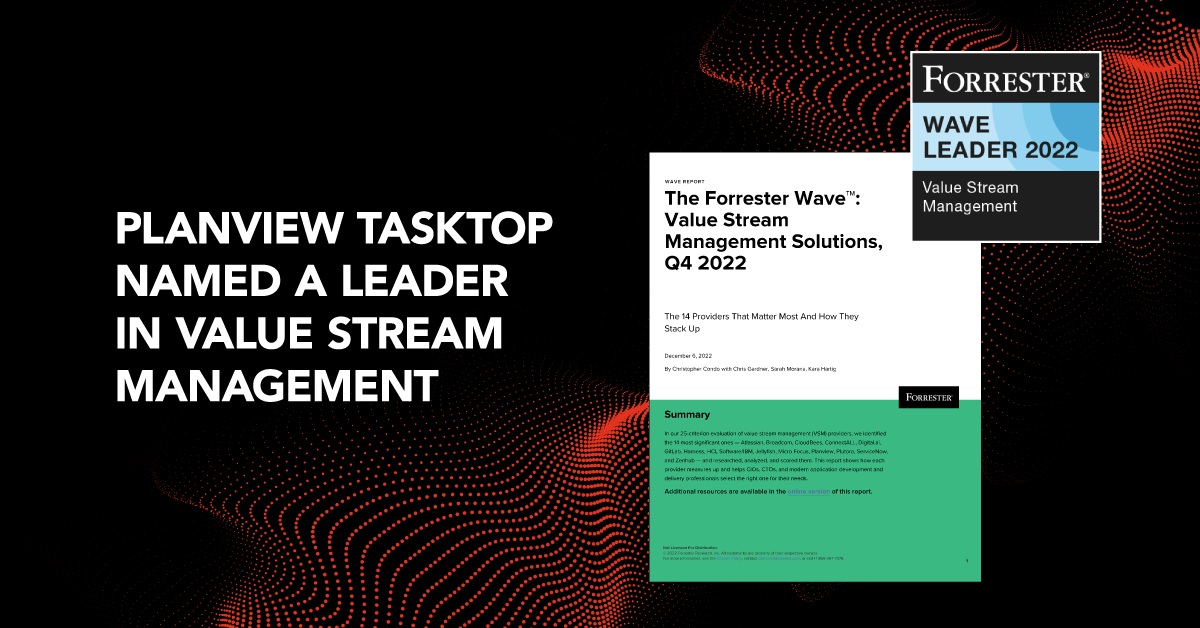
Last month, Planview released the inaugural 2023 Project to Product State of the Industry Report, and it is well worth the read. It examines anonymized data from more than 3,600 value streams, representing over 38,000 individuals across the value chain from ideation to value. To my knowledge, we are the only organization with access to such a large and complex value stream data set.
The data measures the flow of business value through all the activities involved in a software value stream. As a newcomer to Planview with fresh eyes, here is what jumped out at me:
The top-performing segment (eight percent of companies) crosscuts company age, size, industry, geography, and regulatory requirements. This debunks the perspective that business agility and successful transformation are limited to companies of a certain profile.
Speed Matters
Having worked on enterprise transformations for the past 25 years, it’s not surprising to me that the majority of enterprises have not yet transformed to a product model within the last five years and achieved value delivery at a speed we’d associate with digital natives and tech giants.
It’s hard work to get buy-in across supporting functions of a value stream. However, along the way, there is bread for the journey. This is an assignment where you get business credit for partial work, like tackling just one of your value streams end to end.
When you transform one value stream, that value stream shows the improved benefits of speed to customer value, greater security, reduced errors, and risk mitigation of digital disruption. Those are important points to get on the board if that value stream is the highest economic generator for your company.
Speaking of points, let’s talk about speed of points. We see disparity for companies in the same industry, with some delivering business value via their software delivery at three times their prior speed once they start focusing on flow of business value. This is an unprecedented disadvantage for competitors.
I am not just referencing improvements via Agile and DevOps, although they are a piece of the puzzle. I’m also referencing upstream activities, software development technical impediments, and post-build activities. Impediments to speed surface across the entire value stream when organizations have the right instrumentation for an end-to-end view and measure flow of value.
Fresh off the pain of my poor Boilermakers loss in the NCAA tournament, I reflect on what a startling competitive disadvantage you’re at if your competitor can score buckets at three times your team’s speed. I don’t know much about playing badminton, hurling, cricket, or buzkashi, but I’ll bet three times the speed is better every time.
The speed of software delivery is either a competitive advantage or a startling disadvantage in the digital age.
Speed feels risky, but it’s actually risk mitigating as it enables quick response to disruptions — like the need to exit Russia, the 11th largest economy in the world, within weeks. It enables a company to adopt new technology disruptors like ChatGPT and leverage them in operations, as opposed to being disrupted by your competitor, which incorporates the advantage faster.
Speed is customer obsessed as it shortens the cycle between customer input and delivery of a customer product feature. As Adrian Cockroft, AWS VP of Cloud Architecture Strategy, shared on the Mik + One podcast, “When you’re looping faster than your competitors, you get to disorientate them.” This is a phenomenon that Amazon competitors have certainly felt.
An Outcome-Based vs. Constraints-Based Approach to Transformation
When I worked for AWS, I saw two approaches for transformation—an outcome-based approach and a constraints-based approach. At AWS, I assisted customers in their goals of moving out of data centers to realize the business agility benefits of modernized infrastructure. Together, we’d complete a Migration Readiness Assessment (MRA) based on thousands of other AWS engagements.
I saw customers experience outstanding success. I also saw customers start out enthusiastically and then grind down to the dreaded “cloud stall” as they encountered people issues, security issues, approval ticketing process, etc.
We’d review the customer’s cultural, process, and technology environment as part of the MRA and point out what would bite them four months, six months, and 18 months in the future. Some of them would take this report and turn it into their roadmap on what to get right first.
They designed intentionally for the success of their transformation.
With other customers, I didn’t effectively carry the message across the organization, and they would stick the recommendations in a drawer. Six months later, after they’d hit cloud stall, they’d ask us for help, and we’d pull out the recommendations from our assessment and review it. Some would turn it into their roadmap on how to address cloud stall, and some would stick it back in the drawer.
The paradigm I started showing customers was a simple slide on the difference between an outcome-based approach to transformation and a constraint-based approach.
Outcome-based approach
- Define and quantify desired outcomes with the business
- Design approach proportionate to desired outcomes
- Design delivery model proportionate to desired outcomes and anticipated benefits
- Taking action only on what progresses the outcome
Constraint-based approach
- See what we can do with what we have
- With what we have, let’s move something
- Activities and experiments taken to demonstrate progress to leadership
- False starts and cloud stall
When I see that top eight percent, I see intentionality. I see companies recognizing that speed is the differentiating competitive advantage in business. They have that awareness, and they organize around it. They design for speed of business. When faced with tradeoffs in design, speed to value is the first priority.
How Do You Appreciate the Value of Business Agility?
In his book War and Peace and IT, Mark Schwartz describes it best for CFOs—it is the most akin to purchasing an option at a fraction of the cost of the value you may exercise in the future. Designing for business agility, designing for customer listening, designing for speed of tech change, designing for measurement of value streams so that you can optimize—with these investments, you have cheaply acquired the rights to future opportunities that you would otherwise not be able to respond to.
You now have the option of responding to customer sentiment and rolling out a product faster than a competitor. You have the option of rapid response to a security incident. You have lowered the future cost of experimentation and learning which initiatives will yield value.
The pace of transformation matters.
All company execs will agree that transformation and business agility is imperative. The pace with which they invest to get there varies greatly. How many months is it fine to have a competitor delivering business value three times as fast as your company?
A Strong Reason For Optimism Looking Forward
When the industry started down this path, software was used by executives for managing objectives and key results (OKRs). Strategic decision making was disconnected from other essential software such as resource management, portfolio management, spreadsheets, and value stream management software.
Executives lacked visibility into how value stream management connected or mattered to their OKRs. Planview’s software was essential for executives in connecting the execution of work to their strategy. Via the acquisition of TaskTop, executives can now trace and see the impact of the efficiency of delivery of value rolled up to their OKRs (and their executive compensation metrics).
Organizations snap back to old habits unless they have consistent tension pulling them forward.
Executive compensation metrics decisively steer companies’ direction. In an interview with the Bank of New Zealand, we learned that they include metrics on the improvement of value stream delivery in their board-level reporting. This is the right tension needed to add accountability to transformation. The ability for executives to easily check in on success of delivery of value tied to their OKRs attracts allies for transformation. It makes speed of value delivery visible to CFOs, Line of Business (LOB) leaders, and Chief Strategy Officers.
Many of our customers are weathering economic uncertainty. Many readers may find the above sentiment interesting but have been handed a cost-cutting mandate and a number to hit. They are not going to convince their organization to transform today but need to navigate this season. We see a lot of customer executives strategically right-sizing their organization where they are trimming long-term experiments that are not yielding the desired results. They are growing but selectively funding R&D with a closer lens.
I have multiple customer requests to provide insight on this topic. I will follow up this post with a perspective on sensitivity analysis, decision making, and difficult prioritization in an era of growing constraints from hip joints to oil rigs.
Personalized Assessment and Roadmap Offering
Are you struggling to get the most from your project-to-product shift? You can accelerate the remainder of your journey with appropriate prioritization, a concrete roadmap, and a data-driven approach.
Leverage the framework laid out by Planview CTO, Dr. Mik Kersten, in his bestselling book, Project to Product, and its practical and successful application with hundreds of complex enterprises. Mik and his team have had the closest seat at the table and can apply their hard-earned insights and best practices to your specific corporate realities.
In this complimentary offering, you will work with Planview experts to build a practical roadmap to operationalize and sustain a mature product model. Get the results you should be getting with your Personalized Assessment and Roadmap offering.




